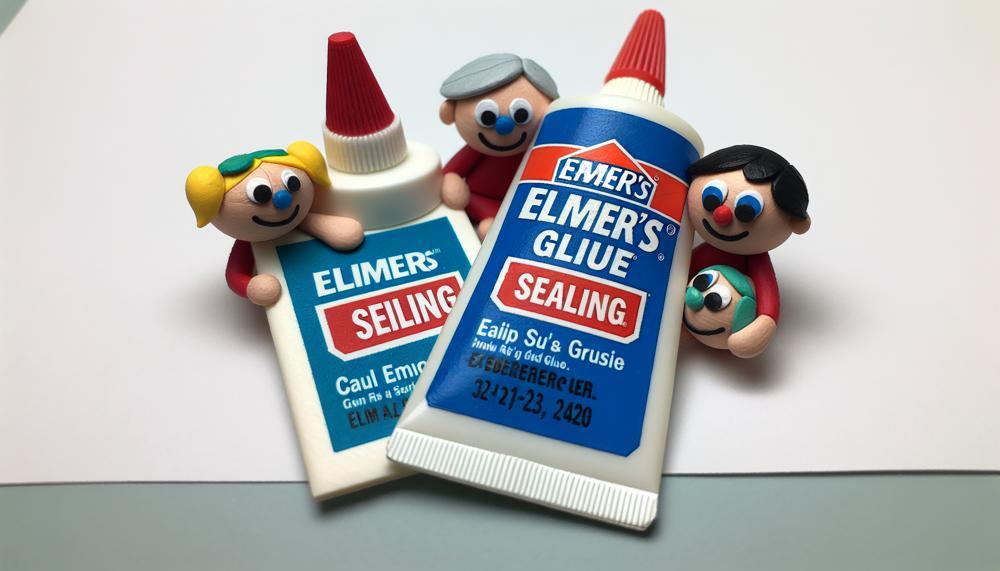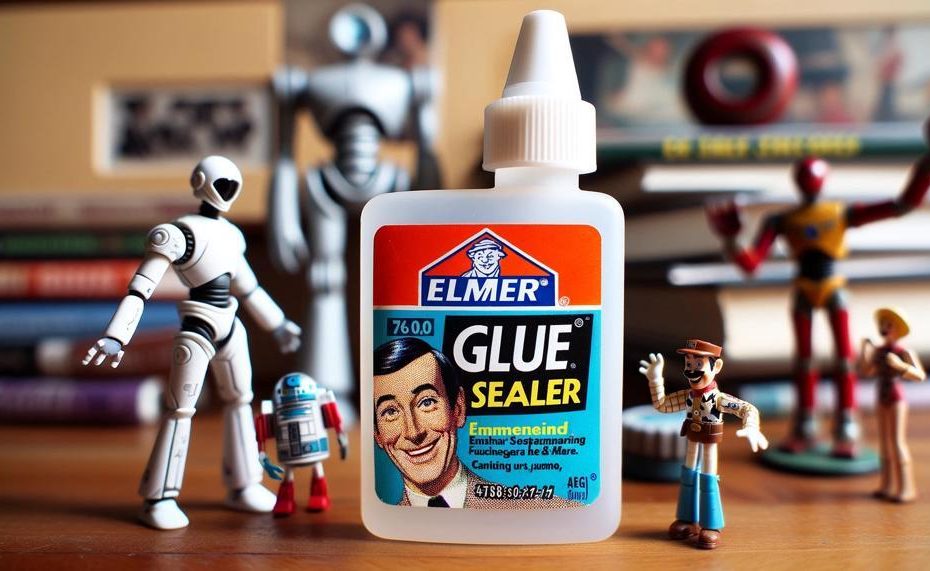Do you find yourself constantly searching for the perfect sealer for your DIY projects? Look no further than your childhood memories – Elmer’s glue. Yes, that’s right, the trusty white glue that held together our arts and crafts can also double as a sealant. But can it really provide the same level of protection and durability as expensive sealers? Keep reading to uncover the truth about using Elmer’s glue as a sealer.
- Budget-friendly and versatile: Why spend a fortune on specialized sealers when you can achieve similar results with a simple bottle of Elmer’s glue? This household staple is not only affordable but also works on various surfaces such as paper, wood, and fabric.
- Easy application: No need for complicated techniques or tools – just use a brush or sponge to apply a thin layer of glue and let it dry completely for a glossy finish.
- Strong protection: Don’t let its humble origins fool you – Elmer’s glue provides strong adhesion and creates a protective barrier against moisture, dust, and other elements that could damage your project.
- Perfect for decoupage: Get creative with decoupage by using Elmer’s glue to seal layers of paper onto any surface. The result? Beautifully crafted projects with a professional-looking finish.
- Customizable finishes: Want to add some color or sparkle to your project? Simply mix in food coloring or glitter with the glue before applying it for personalized finishes that will make your project stand out.
Say goodbye to overpriced sealers and hello to the wonders of Elmer’s glue. Its easy application, durable protection, and customizable finishes make it the perfect choice for all your crafting needs.
So next time you’re working on a DIY project, give this household item a chance – we promise you won’t be disappointed.
Table of Contents
- 1 What is Elmer’s Glue?
- 2 Can Elmer’s Glue Be Used as a Sealer?
- 3 Advantages of Using Elmer’s Glue as a Sealer
- 4 Disadvantages of Using Elmer’s Glue as a Sealer
- 5 Tips for Using Elmer’s Glue as a Sealer
- 6 Different Types of Elmer’s Glue for Sealing Projects
- 7 Alternatives to Using Elmer’s Glue as a Sealer
- 8 Conclusion
What is Elmer’s Glue?
Elmer’s Glue is primarily composed of polyvinyl acetate (PVA), a synthetic polymer that offers both flexibility and strength.
To ensure its effectiveness and shelf life, it also contains various additives like preservatives and stabilizers. As an adhesive, Elmer’s Glue works by creating hydrogen bonds with the surfaces it is bonding as it dries.
These bonds result in a strong adhesion between the surfaces, making it suitable for a wide range of materials such as paper, wood, fabric, and more. Its flexibility and non-toxic nature make it a popular choice for school projects, crafts, and DIY projects.
However, due to its lack of waterproofing and weather resistance, it may not be suitable for outdoor or heavy-duty use. In these cases, it might be better to use alternative options.
Additionally, applying thin layers and testing the seal before completing the project are vital steps for optimal use.
Can Elmer’s Glue Be Used as a Sealer?
Elmer’s glue can certainly be utilized as a sealer for a wide range of materials, if used correctly. However, it may not be suitable for all projects or materials, and there may be other alternatives that could prove more effective in certain situations.
| Material | Effectiveness of Elmer’s Glue as a Sealer | Other Alternatives |
| Porous materials (paper, fabric) | Highly effective with multiple layers and proper application techniques | Mod Podge or polyurethane |
| Non-porous surfaces (plastic, metal) | Moderately effective, but may not provide long-lasting seal | Epoxy resin or silicone sealant |
| Outdoor or harsh conditions | Not recommended due to potential weather and moisture damage | Marine varnish or polyurethane with UV protection |
| Children’s crafts | Safe and effective for non-toxic projects | Kids’ glue or clear school glue |
| Varying surfaces (mixed media) | May work well with certain combinations of materials, but not all | Polyurethane, varnish, or spray sealant |
When considering using Elmer’s glue as a sealer, it is crucial to consider the material being used and the conditions it will be exposed to. Proper application and surface preparation are also key factors in achieving a successful seal.
To ensure better adhesion and durability, diluting the glue with water and applying thin, even layers is highly recommended.
Advantages of Using Elmer’s Glue as a Sealer
There are numerous advantages to using Elmer’s glue as a sealer, making it a top choice among sealers in the market. Not only is it budget-friendly, but it is also highly versatile and dries clear, making it suitable for a variety of projects.
Its ease of application is also a major plus, as it can be easily applied with minimal effort. Additionally, using Elmer’s glue as a sealer adds durability to your project, providing long-lasting results.
Despite its many benefits, there are also some limitations to consider when using Elmer’s glue as a sealer. For instance, it is not waterproof, meaning it may not be the best option for outdoor projects or items that will frequently come in contact with moisture.
Furthermore, it may not adhere well to smooth surfaces, so it is important to consider the texture of your project before applying the glue. Over time, there is also a possibility of discoloration, which may not be ideal for long-term projects.
Disadvantages of Using Elmer’s Glue as a Sealer
Although Elmer’s glue is a widely used and convenient option for sealing various materials, there are some potential drawbacks to keep in mind before using it as a sealant. These include:
| Not impervious to water | One of the primary limitations of using Elmer’s glue as a sealant is its lack of water resistance. This means that it may not provide adequate protection for projects that will be exposed to water or moisture over time. When in contact with water, the glue can become soft and even dissolve, compromising the seal. |
| Possible fragility | Elmer’s glue is not renowned for its flexibility, which can be problematic when used as a sealant. Over time, the glue can become brittle, especially if the surface experiences movement or flexing. This can lead to cracks or peeling, making it less effective as a sealant. |
| Incompatibility with certain materials | While Elmer’s glue works well on porous materials such as paper, wood, and fabric, it may not adhere well to non-porous surfaces like glass or plastic. This can limit its use as a sealant for certain types of projects or materials. |
| May not provide sufficient bonding strength | Elmer’s glue is not the most powerful adhesive on the market, which can be problematic when used as a sealant for heavier objects. It may not provide enough bonding power to keep heavy objects in place, causing them to fall or become damaged over time. |
To overcome these potential limitations, there are alternative sealants that may be more suitable for specific projects. These include products such as Mod Podge, decoupage glue, and polyurethane, which offer better waterproofing and bonding power for different materials.
Tips for Using Elmer’s Glue as a Sealer
For those looking to achieve a strong and durable seal, here are some helpful tips to ensure success with this versatile adhesive.
- Choose the right type of glue: Elmer’s glue comes in various forms, such as liquid, gel, and spray adhesive. For sealing purposes, it is best to opt for the liquid form as it offers better control and coverage.
- Prepare the surface properly: Before applying the glue, make sure to thoroughly clean and dry the surface. This step is crucial for creating a strong bond between the glue and the surface.
- Use thin layers with a brush or sponge: Applying thin layers of glue with a brush or sponge allows for smoother application and better absorption into the surface. It is essential to let each layer dry completely before adding another one.
- Test the seal before completing your project: To ensure a robust seal, it is vital to test it beforehand. Apply a small amount of glue on a scrap piece of the same material and let it dry completely. Once dry, check if the seal is strong enough for your needs.
- Be aware of its limitations: While Elmer’s glue can offer a clear protective barrier, it is not waterproof or weather-resistant. Therefore, it may not be suitable for outdoor use or heavy-duty projects. In such cases, consider using alternative sealants like Mod Podge, polyurethane, silicone sealant, or epoxy.
By following these tips, you can achieve a strong and durable seal for your projects using Elmer’s glue. Remember to always follow the instructions on the product label for best results.
Different Types of Elmer’s Glue for Sealing Projects
There are five unique types of Elmer’s glue that can be used for sealing projects: white school glue, clear glue, carpenter’s wood glue, spray adhesive, and superglue. Each type has its own distinct properties and applications. Let’s take a closer look at each type to gain a deeper understanding of their differences:
White School Glue:
- This is the most commonly used type of Elmer’s glue and is typically used on porous surfaces such as paper and cardboard.
- It is water-based and dries clear, making it an ideal choice for sealing various projects.
- However, it may not be the most suitable option for outdoor use or heavily-used items as it is not waterproof or highly durable.
Clear Glue:
- Similar to white school glue, clear glue is also water-based and dries clear.
- It is versatile and can be used on a variety of surfaces including paper, cardboard, wood, fabric, and plastic.
- The transparent finish makes it a popular choice for sealing projects where appearance is important.

Carpenter’s Wood Glue:
- As the name implies, this type of Elmer’s glue is specifically designed for use on wood surfaces.
- It has a stronger hold than white school glue or clear glue and is also water-resistant.
- Carpenter’s wood glue is well-suited for sealing wood projects that may be exposed to moisture.
Spray Adhesive:
- Unlike the previous types, spray adhesive comes in an aerosol can and is applied as a fine mist rather than a liquid.
- It works well on larger or uneven surfaces where traditional glues may have trouble adhering.
- However, it may be more challenging to control coverage and may not be suitable for smaller or more delicate projects.
Superglue:
- Superglue, also known as cyanoacrylate adhesive, is a strong and fast-setting adhesive commonly used for bonding materials together.
- It can also be used as a sealer on certain surfaces, but it is not recommended for use on large or porous surfaces.
- Superglue dries clear and is waterproof, making it a good option for sealing smaller items or projects that require a strong hold.
Alternatives to Using Elmer’s Glue as a Sealer
When it comes to using Elmer’s glue as a sealer, there are various alternative options to consider based on your project’s needs. These include specialized sealants like Mod Podge, polyurethane, epoxy resin, and shellac.
Mod Podge is a popular choice for paper-based projects as an alternative to Elmer’s glue. It offers a durable and moisture-resistant seal, making it ideal for scrapbooking and decoupage projects. Furthermore, Mod Podge comes in different finishes such as matte, gloss, and satin, allowing for personalization.
For sealing wood and other porous surfaces, polyurethane is a clear and waterproof option. It provides excellent protection against scratches, heat, and chemicals, making it suitable for high-use items like furniture.
Epoxy resin is a strong and long-lasting sealant made up of two parts. It is commonly used for sealing wood, metal, and concrete surfaces because of its resistance to UV rays, moisture, and chemicals. However, it requires precise mixing and application techniques and can be more expensive than other sealants.
Another alternative for sealing wood surfaces is shellac. It dries quickly and gives a glossy finish while also protecting against water damage. However, it may not be as durable as polyurethane or epoxy resin.
Conclusion
In summary, Elmer’s glue is a cost-effective and versatile option for sealing DIY projects.
Its ease of use, durability, and customizable finishes make it a great alternative to expensive sealers. However, it may not be suitable for all materials and projects.
It is crucial to consider the specific requirements of your project before using Elmer’s glue as a sealer and to follow proper application techniques for optimal outcomes.






